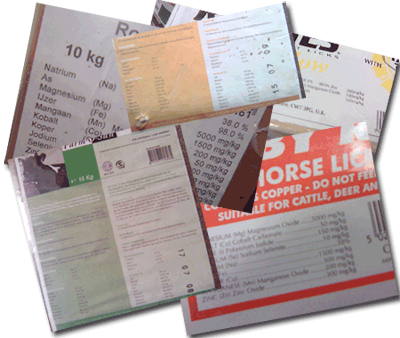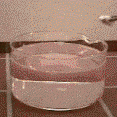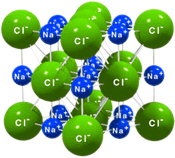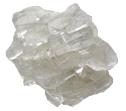This page is an automated translation of /nl/mineralblocksresearch.html and has not been reviewed yet.

- About licks
- Mineral (#vergelijk) compared
- Conclusion
- FAQs
- (#bronnen)
- The lick stone based on Dutch soil
Suppose that there are 400,000 horses in the Netherlands, and that they consume an average of 20 grams of lick stone per day. Then in the Netherlands nearly 3 million kilos of lick stones are eaten every year. It is therefore high time to consider the composition of lick stones. We are going to do a number of calculations on this page, do you keep your calculator at hand?
With 3 million kilos of licks per year in our small frog country alone, you can say that licks are a nice commodity. Manufacturers therefore do their best to obtain as large a share of the market as possible. Licks are presented as a product with a sophisticated composition that has been preceded by years of research. In addition, there is a current that likes to emphasize the natural and import licks from places that appeal to the imagination such as the Himalayas.
You would expect that all the research ultimately led to one optimal composition for the lick stone, and that all lick stones look just as similar as today's compact family cars, which are also so similar because only one formula is the most ideal. But nothing could be further from the truth: the licks differ significantly from each other, and as you will see below, there is actually not a single lick stone that is really ideal for horses that receive a natural diet consisting of nothing more than grass or hay.
Update: Three years after writing this article, we found a manufacturer who wanted to make the ideal lick for us. Read more here .
About licks
About Sodium
 When we talk about sodium, we don't actually mean pure sodium. Pure sodium is unsuitable for consumption, to say the least: in contact with oxygen it spontaneously catches fire, and in contact with saliva it explodes.
When we talk about sodium, we don't actually mean pure sodium. Pure sodium is unsuitable for consumption, to say the least: in contact with oxygen it spontaneously catches fire, and in contact with saliva it explodes.
 Sodium is generally consumed as a compound with chlorine. Chlorine is not a sweetheart either: in the First World War it was used as poison gas. But the amazing thing is that the connection between sodium and chlorine produces the very stable sodium chloride. Sodium chloride is the chemical name for ... table salt!
Sodium is generally consumed as a compound with chlorine. Chlorine is not a sweetheart either: in the First World War it was used as poison gas. But the amazing thing is that the connection between sodium and chlorine produces the very stable sodium chloride. Sodium chloride is the chemical name for ... table salt!
The atomic weight of sodium is 11, the atomic weight of chlorine is 17. If you convert this to percentages, the sodium accounts for 39% of the weight of table salt. The sodium content of a lick stone can therefore never exceed 39%. In most licks the percentage of sodium is 38%. The remainder is chlorine, and then there is only one percent left for the trace minerals and any additives.
Before we can assess the various licks, we must first determine what the purpose of the lick stone is. Anyone who does some maths (see our Nutritional calculator ) will soon see that the average Dutch pasture can meet the horse's mineral needs perfectly. With one exception: Sodium. It is still just when the horse does not work and hardly sweats, but in all other cases the average pasture contains far too little sodium, and this is the reason that you should always offer a horse a lick. In fact, a lick that contains only sodium compounds could be enough, but a lick stone can be very useful to immediately offer some extra minerals. We call such a lick a mineral block.
You may be wondering why we don't just sprinkle sodium on the horse's food. The reason is that the horse's sodium requirement is very individual. There is no such thing as a "standard value" for sodium: it is highly dependent on muscle work, perspiration and kidneys secretion. If we were to feed horses a standard value of sodium, one horse could become seriously deficient, while another horse would get too high blood pressure due to the sodium surplus. Horses must therefore be able to absorb sodium entirely according to individual needs, and that is perfect when your horse has access to a lick stone.
Why does a horse lick a lick?
For horses, sodium is always a bit of a concern, which is why nature has ensured that horses actively look for "something salty" as soon as the sodium level threatens to become too low. It is this programmed sodium craving that makes horses lick a lick. Once the horse has taken in enough sodium, the need for a salty taste disappears, and the horse stops licking or even dislikes salty things.
People are programmed in the same way. Those who have too little sodium get a lot of appetite for salty tasting food, those who have enough sodium will prefer to sprinkle a little less salt on their food. However, there is a catch: When you hide the salt in a food that is very tasty (such as salty licorice) then you are inclined to eat it, even if you have already taken in more than enough sodium. In this case, the automatic limitation no longer works. Why we tell this? Because with horses, the same applies: Craft an apple-flavored lick together, or sprinkle a pot of molasses on top, and the horse will eagerly use the stone, and ingest way too much salt. The horse no longer licks the stone to supplement its sodium deficiency, but because of the stone's high candy content.A lick should therefore have a neutral taste. Please note: a horse only licks on a lick to satisfy its sodium requirement. There are no indications that a horse can also detect trace elements. It is therefore easy to give a horse an overdose of a certain mineral when this mineral is hidden in too large amounts in the mineral block.
Pasture horses
In drawing up our requirements and assessing the licks, we have assumed that they apply to horses that receive a natural diet: so only grass and/or hay, but no grain products or unnecessary supplements.* (Please also read our page on Natural Food natural food (*naturalfood) for more information.) *
The influence of this on the assessment of the licks is twofold:
- The mineral values of many pure grain products are very skewed, but this can then be somewhat rectified by using a lick stone with an equally peculiar mineral ratio. Not surprisingly, the mineral values of grass are fairly good in proportion, so it is best to supplement grass with a mineral block with a reasonably neutral composition. A mineral block with skewed mineral ratios therefore produces a skewed result.
- Horses that only receive grass and/or hay will eat much more of this than horses that also receive concentrates. The larger amount of grass and/or hay also means that the horses will receive much more minerals. The horse therefore does not need any further supplementation of most of the minerals that are abundant in grass. The minerals that are sometimes a bit on the low side in grass, such as copper and zinc, the horse will need earlier. This problem is probably not the case with horses that live on concentrates, but they benefit from an extra supplementation of some minerals that do not occur in grains, but in grass. Horses that receive a natural diet may therefore need a different mineral supplement than horses that receive fast food.
We have assumed an average horse, a 500 kilo horse that performs light work. For this we used our online food calculator , which uses the target (*foodcalculator) in the literature for its calculations. With the feeding calculator it is easy to calculate the nutritional needs of your own horse.
Which minerals should* not *be better in a lick?
A mineral block allows us to easily give the horse some additional minerals, as long as we are sure that we are not inadvertently giving the horse a surplus. And that is more difficult than it seems.
- Selenium (Se)
- A horse needs between 1 and 3 milligrams of selenium per day, but according to experts more than 5 milligrams per day can cause symptoms of poisoning. Because the use of the lick stone is very individual, it will be impossible to apply just so much with a lick stone that the horse that licks little does not develop a deficiency, and a horse that licks a lot does not incur a dangerous surplus. It is therefore better to administer selenium separately, in an appropriate dose combined with vitamin E, and only when it has been determined that the horse is not already getting enough selenium through its normal diet.
- Iron (Fe) and Manganese (Mn)
- Iron is necessary for the production of red blood cells, but at the same time iron is a very nasty substance for the body: it belongs to the free radicals. It damages cells, causes aging, cardiovascular disease and cancer. An excess of iron prevents the absorption of copper and zinc. The iron that is not needed for the production of red blood cells is therefore undesirable. A horse weighing 500 kilos needs 0.4 grams of iron per day, if that horse eats about 7 kilos of grass or hay per day, it will consume more than 0.6 grams of iron on average. And we are not even talking about drinking iron (ground) water. The dose of manganese is linked to the dose of iron, so if you are not adding iron, you should not add manganese either.
- Calcium (Ca)
- There is an ideal ratio between Calcium, Phosphorus and Magnesium. However, it is unfortunately still unknown to many that this ratio is no longer valid when you increase the amount of this trio. The body has a preference for calcium, absorbs it first and, after saturation, flushes away the excess along with the not yet absorbed magnesium. If there is too much calcium in the food, magnesium is hardly or not at all absorbed, even if the theoretical ratio is correct. A 500 kg horse needs about 35 grams of calcium per day; such a horse eats about 8 to 9 kilos of hay, and thus already consumes 50 grams of calcium. Adding extra calcium by means of a lick is therefore undesirable, and this applies in particular if the magnesium value is not also boosted to the corresponding level. Read our article on Magnesium for more information.

Which minerals should* be *better in a lick?
- Sodium (Na)
- Yes duh, you might think, but some manufacturers have turned the lick into a survival kit, which has reduced the sodium content. For example, with the Horselyx mineral block, the horse will have to eat about half a kilo of the block to get 10 grams of sodium ...
- Zinc (She)
- Zinc is one of the minerals that can be marginal if you only feed your horse hay or grass. In the vast majority of cases, your horse will not develop a deficiency, but it is nice if your horse gets a little extra through the lick stone. The margin between the minimum requirement and a toxic amount is ample for zinc.
- Magnesium (Mg)
- Your horse will get enough magnesium through grass and hay. But it is now known that an abundance of Magnesium helps the body to limit the harmful influence of fructan-rich grass . Magnesium is one of the few minerals that has no harmful effects in larger quantities. It is therefore a consideration to give extra magnesium to horses that live on fructan-rich grass (as is unfortunately common in Western Europe).
- Copper (Cu)
- Copper is one of the minerals that can be marginal if you only feed your horse hay or grass. In the vast majority of cases, your horse will not develop a deficiency, but it is nice if your horse gets a little extra through the lick stone. The margin between the minimum requirement and a toxic amount is ample for copper.
Other stuff that* doesn't *belong in a mineral block
- Flavors
- As we explained earlier on this page, a horse will lick a lick just enough to satisfy its sodium requirement. As soon as you add flavors to it, it quickly becomes candy, and the nicely regulated sodium intake of the horse is no longer available. The horse does not stop licking once it has absorbed enough sodium; the whole bag of salty liquorice must be empty. Good for the manufacturer, but not for the horse.
- Molasses
- Molasses is a favorite ingredient, at least for the manufacturer. It's cheap, you can stick well with it, and horses love it, so the owner will soon come back to buy a new stone. We now know that molasses is particularly bad for horses. For his teeth, for his intestinal flora, and for his carbohydrate balance. Moreover, the same drawbacks apply to the addition of molasses as to the use of tasty flavors.
- Products of animal origin
- In recent years, the livestock industry has repeatedly shown that it is not such a fantastic idea to provide herbivores with food of animal origin. It should be obvious, but unfortunately there are still manufacturers who, for example, use cod liver oil or fish oil in their products. We can have a long discussion on this, but perhaps it is enough to consider that a horse will not soon start eating whales on its own, and that its digestive system and defenses are simply not optimally equipped for this.
- Organic substances
- You can of course add vitamins, proteins, seaweeds, algae, fungal cures, etc. to a lick. Apart from the fact that this misses the mark a bit (is it still a mineral block or is it a complete meal?), Organics are not very compatible with the way licks are used. Organic substances are poorly resistant to repeated exposure to moisture (licking!), Sunlight, frost, high temperatures, etc. Not only are the vitamins short-lived, measures will therefore have to be taken to prevent spoilage by fungi and bacteria. and these measures usually consist of the addition of all kinds of preservatives. It is better to just leave the lick a lick, and to provide any other things to the horse in a different way.
- Preservatives
- Salts are generally very stable and not perishable. Table salt, for example, does not make any critical demands on the way you store it and cannot go bad. As long as there are no strange things in the lick, preservatives are therefore not necessary. If it does contain preservatives, this is an indication that some peculiar ingredients are hidden in the stone.
Lick block properties
- Organic/Organic
- Don't be fooled. Minerals are by definition not of biological or organic origin. Minerals are the parts that make up our earth. For example, sand (Silicon) is also a mineral, and what could you imagine with "pure sand of biological or organic origin"? It is possible to link an element to a protein, you then get a chelate form, but these organic bonds are unsuitable for use in licks because they are sensitive to moisture, sunlight, high temperatures, frost, bacteria and fungi. Therefore only a mineral form is used in lick stones.
- Color
- The color of stones says little about the content. The vast majority of stones consist of at least 99% sodium chloride, which has a white color, and the remaining 1% of trace elements is not enough to give a stone a deep color. The red color of horse licks is simply a food coloring. A colored stone does not necessarily have to be a problem, as long as the stone is not chosen because it has such a beautiful color. After all, you are buying a food, not jewelry.

- Crystal shape
- Salt arranges itself in a crystal shape. These crystals can take on enormous shapes. Most manufacturers choose to start from small crystals and press them together. However, there is no chemical difference between small and large crystals, you can make small salt crystals into large crystals and vice versa. It depends on how well you stir during evaporation, to put it simply.
Mineral blocks compared
Below are the mineral values of some mineral blocks. The first table consists of the data provided by the manufacturer and/or supplier. In order to be able to properly compare the data of the different mineral blocks, we have* normalized * the data in the second table. We have assumed an average lick requirement of 20 grams of lick stone per day, if this block consisted of 99% NaCl (kitchen salt). If a lick stone contains half the sodium, the horse will lick twice as much of the stone to satisfy its sodium requirement, and thus also get twice as much of the other minerals. In this way it is comparable what a horse with an average sodium requirement per brand of lick in other minerals consumes. Of course you can extrapolate the data from the second table to the actual lick stone consumption of your own horse.